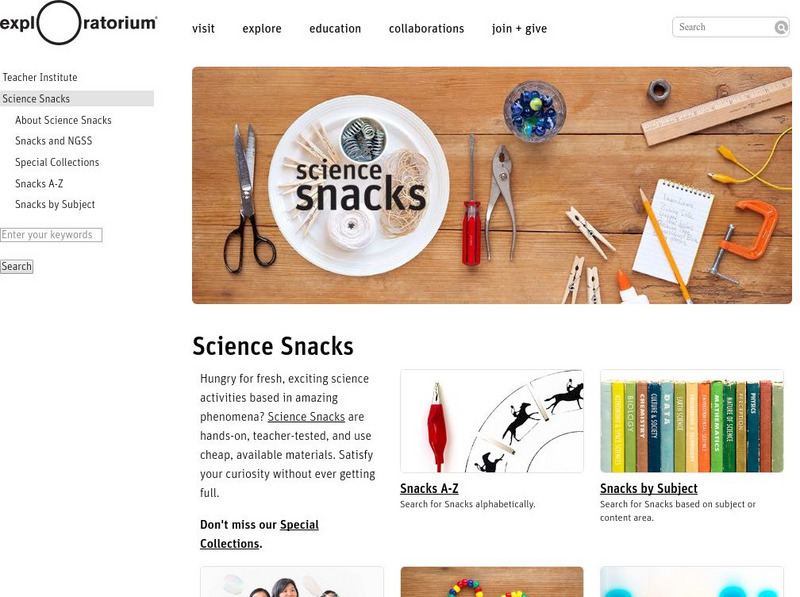ClassFlow
Class Flow: Compound Nomenclature and Formulas
[Free Registration/Login Required] This flipchart provides an introduction to naming and writing formulas for compounds and includes assessment questions.
ClassFlow
Class Flow: Ionic & Covalent Compounds
[Free Registration/Login Required] This flipchart presents rules for writing and naming ionic and covalent compounds. There is a short assessment using Activotes.
ClassFlow
Class Flow: Matter, Property and Changes
[Free Registration/Login Required] This flipchart contains a review quiz for high school chemistry on matter, property and changes.
Exploratorium
Exploratorium: Snacks
Exploratorium's snacks aren't edible, but they are good! Use your science skills to discover gravity, learn about biology, do fun experiments.
Environmental Chemistry
Environmental chemistry.com: Molar Mass Calculations
Provides a definition for both mole and molar mass and gives a step-by-step example problem to work through that shows how to compute molar mass. Also has a a molar mass calculator in which you can practice problems on.
Indiana University
Indiana University Northwest: Molar Mass
This site shows how to compute molar mass by working through an example.
Ducksters
Ducksters: Chemistry for Kids: Elements: Tin
On this site, kids learn about the element tin and its chemistry including atomic weight, atom, uses, sources, name, and discovery. Also find the properties and characteristics of tin.
Ducksters
Ducksters: Chemistry for Kids: Soaps and Salts
Kids learn about soaps and salts in chemistry including interesting facts, how soap is made, how soap works, and what are salts in this site.
Ducksters
Ducksters: Chemistry for Kids: Elements: Sodium
Kids learn about the element sodium and its chemistry including atomic weight, atom, uses, sources, name, and discovery. Plus properties and characteristics of sodium are discussed.
Ducksters
Ducksters: Chemistry for Kids: Solutions and Dissolving
On this site, students learn about solutions and dissolving in chemistry including interesting facts, examples, solubility, saturation, concentration, and what is a solution?
Ducksters
Ducksters: Chemistry for Kids: Elements: Sulfur
Explore the properties and characteristics of sulfur on this site. Kids can learn about the element sulfur and its chemistry including atomic weight, atom, uses, sources, name, and discovery.
Ducksters
Ducksters: Chemistry for Kids: Separating Mixtures
Kids learn about separating mixtures in chemistry including separation processes such as filtration, distillation, and the centrifuge.
Ducksters
Ducksters: Chemistry for Kids: Elements: Silicon
Investigate the properties and characteristics of silicon. Students can study the element silicon and its chemistry including atomic weight, atom, uses, sources, name, and discovery.
Ducksters
Ducksters: Chemistry for Kids: Radioactivity and Radiation
Kids learn about the science of radioactivity and radiation in chemistry including radioactive decay, types, measurements, half-life, and the dangers.
Ducksters
Ducksters: Chemistry for Kids: Elements: Potassium
Study the properties and characteristics of potassium on this site. Learn about the element potassium and its chemistry including atomic weight, atom, uses, sources, name, and discovery.
Ducksters
Ducksters: Chemistry for Kids: Elements: Platinum
Explore information about the element platinum and its chemistry including atomic weight, atom, uses, sources, name, and discovery. Also learn about the properties and characteristics of platinum on this site.
Ducksters
Ducksters: Chemistry for Kids: Elements: Post Transition, Poor, Other Metals
Kids learn about the post-transition, poor, and other metals of the periodic table. Which elements are in this group. Properties, similarities, and other facts.
Ducksters
Ducksters: Chemistry for Kids: Elements: Metalloids
Kids learn about the elements that are considered metalloids on the periodic table. This site describes the properties, similarities, and other facts.
Ducksters
Ducksters: Chemistry for Kids: Elements: Nitrogen
Kids learn about the element nitrogen and its chemistry including atomic weight, atom, uses, sources, name, and discovery. Plus properties and characteristics of nitrogen.
Ducksters
Ducksters: Chemistry for Kids: Elements: Neon
Discover the properties and characteristics of neon on this site.
Ducksters
Ducksters: Chemistry for Kids: Elements: Manganese
Research the element manganese on this site by finding its chemistry including atomic weight, atom, uses, sources, name, and discovery. Plus properties and characteristics of manganese.
Ducksters
Ducksters: Chemistry for Kids: Elements: Mercury
Kids learn about the element mercury and its chemistry including atomic weight, atom, uses, sources, name, and discovery. Plus properties and characteristics of mercury.
Ducksters
Ducksters: Chemistry for Kids: Naming Chemical Compounds
Learn about naming chemical compounds in chemistry including conventions, the order of the elements, metals, non-metals, acids, and examples on naming on this site.
Ducksters
Ducksters: Chemistry for Kids: Organic Chemistry
Kids learn about organic chemistry including the importance of carbon, organic molecules, compounds, hydrocarbons, synthesis, and functional groups.

























